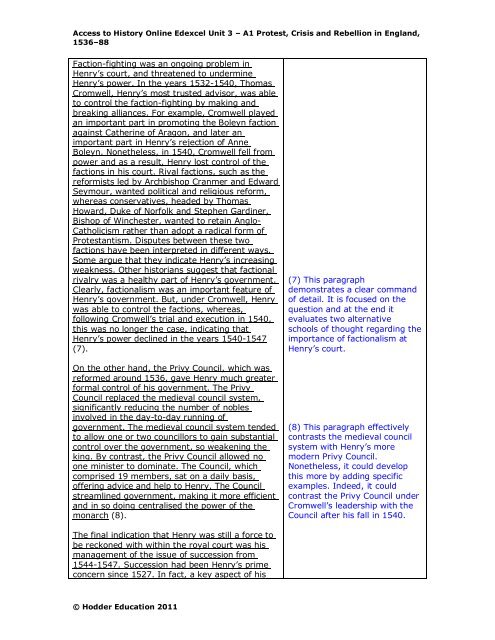Edexcel – Unit 1 - Access to History 2
Edexcel – Unit 1 - Access to History 2
Edexcel – Unit 1 - Access to History 2
You also want an ePaper? Increase the reach of your titles
YUMPU automatically turns print PDFs into web optimized ePapers that Google loves.
<strong>Access</strong> <strong>to</strong> His<strong>to</strong>ry Online <strong>Edexcel</strong> <strong>Unit</strong> 3 – A1 Protest, Crisis and Rebellion in England,1536–88Faction-fighting was an ongoing problem inHenry’s court, and threatened <strong>to</strong> undermineHenry’s power. In the years 1532-1540, ThomasCromwell, Henry’s most trusted advisor, was able<strong>to</strong> control the faction-fighting by making andbreaking alliances. For example, Cromwell playedan important part in promoting the Boleyn factionagainst Catherine of Aragon, and later animportant part in Henry’s rejection of AnneBoleyn. Nonetheless, in 1540, Cromwell fell frompower and as a result, Henry lost control of thefactions in his court. Rival factions, such as thereformists led by Archbishop Cranmer and EdwardSeymour, wanted political and religious reform,whereas conservatives, headed by ThomasHoward, Duke of Norfolk and Stephen Gardiner,Bishop of Winchester, wanted <strong>to</strong> retain Anglo-Catholicism rather than adopt a radical form ofProtestantism. Disputes between these twofactions have been interpreted in different ways.Some argue that they indicate Henry’s increasingweakness. Other his<strong>to</strong>rians suggest that factionalrivalry was a healthy part of Henry’s government.Clearly, factionalism was an important feature ofHenry’s government. But, under Cromwell, Henrywas able <strong>to</strong> control the factions, whereas,following Cromwell’s trial and execution in 1540,this was no longer the case, indicating thatHenry’s power declined in the years 1540-1547(7).On the other hand, the Privy Council, which wasreformed around 1536, gave Henry much greaterformal control of his government. The PrivyCouncil replaced the medieval council system,significantly reducing the number of noblesinvolved in the day-<strong>to</strong>-day running ofgovernment. The medieval council system tended<strong>to</strong> allow one or two councillors <strong>to</strong> gain substantialcontrol over the government, so weakening theking. By contrast, the Privy Council allowed noone minister <strong>to</strong> dominate. The Council, whichcomprised 19 members, sat on a daily basis,offering advice and help <strong>to</strong> Henry. The Councilstreamlined government, making it more efficientand in so doing centralised the power of themonarch (8).(7) This paragraphdemonstrates a clear commandof detail. It is focused on thequestion and at the end itevaluates two alternativeschools of thought regarding theimportance of factionalism atHenry’s court.(8) This paragraph effectivelycontrasts the medieval councilsystem with Henry’s moremodern Privy Council.Nonetheless, it could developthis more by adding specificexamples. Indeed, it couldcontrast the Privy Council underCromwell’s leadership with theCouncil after his fall in 1540.The final indication that Henry was still a force <strong>to</strong>be reckoned with within the royal court was hismanagement of the issue of succession from1544-1547. Succession had been Henry’s primeconcern since 1527. In fact, a key aspect of his© Hodder Education 2011
















